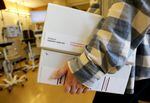medicine to treat Alzheimer’s sickness were in building for many years. however nearly every scientific trial has ended in disappointment.
One concept is that we’re treating people too late and not long enough.
Now, Oregon health & Science institution is taking part in one of the first studies that tries to intervene past, with match 55- to eighty-year-olds who are at risk for setting up Alzheimer’s disorder as they age.
It’s a world medical trial known as the forward analyze, funded via the countrywide Institutes of fitness and the pharmaceutical company Eisai.
whereas medical trials turn up the entire time, this one comes at a moment when the scientists focused on Alzheimer’s research are questioning even if the dominant conception of what explanations the sickness, generic as the amyloid hypothesis, might possibly be incorrect.
The forward study is each a look at various of a single promising drug and an effort to discover more proof about how Alzheimer’s starts.
The leading center of attention of the study is a drug known as lecanemab. It’s simply been given accelerated approval by means of the FDA for use in patients with early or light Alzheimer’s. And it’s the primary drug backed via respectable information that suggests it could actually decelerate the progression of Alzheimer’s sickness â€" not plenty, just a little.
It’s called an anti-amyloid antibody. Some scientists suppose lecanemab and different anti-amyloids beneath construction will work better if they are given to americans earlier than they begin to screen commonplace Alzheimer’s signs, like reminiscence loss.

Vancouver resident Barbara Klausman and Dr. Aimee Pierce prepare for Klausman to get an infusion in November 2022. Klausman volunteered for the ahead analyze to be taught extra about her very own possibility from Alzheimer's sickness, which runs in her family.
Amelia Templeton / OPB
Barbara Klausman is simply the kind of person the ahead researchers are searching for to participate of their look at. Klausman lives in Vancouver. She’s 76. but on a November day ultimate fall, wearing jeans and elegant dark eco-friendly tennis shoes that matched her sweater, she looked plenty more youthful.
“I look forward to waking up daily as a result of there’s always something to do,†Klausman pointed out that day, sitting in a small clinical office at OHSU and getting equipped for an infusion of what could were lecanemab. It also, she knew, might just be saline answer â€" a placebo.
She has a extremely very own reason behind volunteering to get these infusions.
“It was in 1989, my brother turned into in the military as a dentist in Europe and i wrote him letters asserting: ‘There’s some thing wrong with mom,’†Klausman pointed out.
Klausman watched as Alzheimer’s disease slowly took further and further of her mom’s mind. Klausman did what she might to be there for her mother. If she was having an episode of agitation within the middle of the nighttime, her dad would call.
“and that i’d simply go decide upon her up and take her for a cup of coffee, after which she’d forget she was upset and that i’d take her domestic,†Klausman mentioned.
The disorder progresses slowly for many. As neurons within the mind die, patients journey memory loss, then dementia and ultimately death. Alzheimer’s is among the main causes of death for people sixty five and older.
Klausman’s mom died in 2003. but she felt she’d misplaced her mother years previous.
“It’s just complex to see someone you love going via that,†Klausman observed ultimate fall, pretty much twenty years after her mom’s loss of life. “likely the closing eight years it wasn’t her anymore. but she still necessary to be cherished.â€
Klausman’s aunt also had Alzheimer’s and might be her grandfather too. Klausman puzzled if her family historical past put her at risk as she aged. That question led her to the group of researchers at OHSU who were part of the forward look at.
“It’s without doubt the case that with Alzheimer’s, as with different illnesses, that if we are able to become aware of it early and treat it early, we’ll have a better possibility of combating it,†referred to Dr. Aimee Pierce, a geriatric neurologist and the study lead at OHSU.
Pierce and her group are the use of brain imaging to seem for two different markers of the ailment: amyloid plaques and tau tangles.
We’ll come again to tau later. First, amyloid.

no person is aware of for sure what reasons Alzheimer’s ailment, however for a long time scientists have thought a protein fragment referred to as amyloid beta looks suspicious. It types peculiar plaques in the brains of patients. And there’s some genetic proof from households with early-onset familial Alzheimer’s and people with Down syndrome that elements to this selected protein.
Anti-amyloid antibodies, like lecanemab, can clear the plaques from sufferers’ brains. however in scientific trials, those medication haven’t slowed down the progression of patients’ dementia tons, if at all.
That’s why they’re attempting to give them to individuals a long time prior, when the plaques are only starting to boost.
“We be aware of that these plaques are found in patients with Alzheimer’s sickness,†Pierce stated. “however we suppose that they form many, decades before the indicators of Alzheimer’s develop.â€
at the moment, Klausman doesn’t have indicators of Alzheimer’s, no strange memory loss or anything that might make most regularly occurring practitioners suspicious. but mind scans validated she has amyloid plaques already constructing in her mind and will be in danger for the sickness.

The forward look at is producing a trove of facts on the two protein fragments that may trigger Alzheimer's disease, amyloid beta and tau. It takes four binders to hang the statistics collected from Barbara Klausman all through her first 12 months within the trial.
Amelia Templeton / OPB
essential caveat right here: not each person with the plaques will strengthen Alzheimer’s; it’s only a risk component.
As a participant within the study, Klausman has been getting infusions at least as soon as a month at OHSU.
“It’s by no means that bad. It’s under no circumstances that dangerous,†she reassured the therapist surroundings the IV in her arm ultimate October.
“neatly that’s good,†he quipped. “for those who display up with needles, you don’t need americans to hate you.â€
This approach â€" checking out a preventative treatment in a protracted trial with a drug that must be given through an IV and may have very critical side consequences â€" it’s a whole lot to ask of examine contributors.
Klausman joined this trial a 12 months ago. She’s bought three greater years of infusions forward of her.
She additionally comes in periodically for two several types of mind scans. And, to aid the scientists see if getting lecanemab protects against reminiscence loss, Klausman has to take a lot of cognitive checks.
“It’s no longer my favorite factor,†she talked about of the assessments. “i love to ace a test.â€
And, to offer protection to the reliability of the analysis facts, she doesn’t comprehend what the tests have discovered. The look at is what’s referred to as double-blinded and placebo-controlled. That means half the members have become a placebo, now not the precise drug. To stay away from any bias, neither Klausman nor the researchers recognize what neighborhood she’s in. She won’t find out unless the study is over.
“You recognize the selections, between what may be published â€" one can be a real downer,†she stated.
this is science in development, so there’s no make sure that despite the fact that Klausman is getting lecanemab that it'll work.
right here’s one large reason behind skepticism: Amyloid plaques, the component lecanamab clears from the brain, may now not be the underlying reason behind Alzheimer’s in any case. They’ve been the focal point of most analysis, but some scientists suppose the plaques are a red herring, or are even a part of the body’s effort to give protection to mind cells from hurt. very nearly, the plaques may no longer be the wound, however the bandage.

So some scientists feel the actual perpetrator is whatever thing else. possibly, it’s tau. That’s the other protein fragment that’s a signature of this ailment. in the brains of Alzheimer’s sufferers, tau indicates up as tangles interior neurons. they have got been hard to see on mind imaging scans of living patients until incredibly these days.
For a long time, the prevailing idea has been that the buildup of amyloid by hook or by crook triggers the destructive tau tangles. however as anti-amyloid remedies have did not work, scientists have increasingly wondered that theory, Pierce mentioned.
She referred to the question now could be: “Does the amyloid plaque really accumulate earlier than the tau tangles increase? and that's in fact distinctly complicated to determine,†she spoke of. “It takes rather a protracted-time period analyze.â€
The forward examine is likely one of the first to trap photos of each amyloid and tau in the brain scans of more than a thousand older adults.
Pierce and the relaxation of the group may be able to examine these images to how the contributors are acting on their cognitive checks. And that could help crack the central mystery of how Alzheimer’s starts.
For Klausman, the explanation for collaborating is very clear. she can play a component in discovering a treatment for the disease that claimed her mom. She also has two daughters, so when she thinks about her family heritage and the chance of the ailment, she’s also thinking of them.
it could be great if a cure became accessible in her lifetime, but she’s not counting on it.
“via having studies like this one, by the point they should worry about it, which would be about 20 years from now, there received’t be a be concerned anymore or there will be a medicine,†Klausman noted of her daughters. “So sure, i am doing this for them and for future generations.â€

Post a Comment